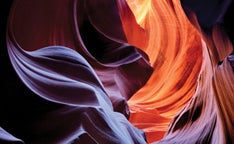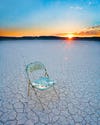How To: Take Better Landscape Photos
Follow these three basic steps for harmony and balance in your landscapes.


How To: Improve Your Landscape Photographs
Composition in art has provided a topic of discussion—and controversy—for millennia. From the ancient Greeks to present-day digital photographers, design theories, rules, and formulas attempt to define and quantify that elusive concept of aesthetics: What looks ideal? Rather than tackle the problem head-on, I’ve come up with a few basic guidelines that can yield a profound improvement in your landscape photographs. In fact, it’s as simple as A, B, C: Angle, Balance, and Crop.
Find the Right Angle
The most common enemy of good composition is impulse: A subject attracts you, you make a few exposures, then you move on to continue the hunt. Chances are, though, your angle won’t be ideal at the precise moment you discover your subject. So before shooting, slow down!
Examine the scene you want to photograph to determine where best to position yourself relative to both the subject (your perspective) and the direction of light. This is often a simple matter of just walking and observing. Consider how your angle aligns other elements in the scene with your main subject. Look for leading lines you can exploit by changing your position, or distracting objects that you can leave out of the frame with a change of perspective. See if the angle of the light will be more favorable in a different spot at another time of day.
In the landscape at top right, I chose an angle that prevented the distant rock formations from being obscured by other elements, and cropped so that the arch frames the scene.
Balance the Element
Your photo is more than just your main subject. Balance is about finding the best placement of all the elements in the frame relative to each other and to the edges. A balanced composition is one where all of these are in harmony.
Your major adjustments here will be the subject-to-camera distance and the direction of the camera. Look for visual relationships— elements that are larger or smaller than one another, colors and tones that complement or clash, or elements that share lines and contours. A tripod that allows camera placement anywhere from ground level on up is an invaluable tool here.
To draw attention to a particular area, make sure it stands out, whether in size, color, or placement. But, at the same time, make sure that one side of the frame is not disproportionately “heavier” than the other, and that important elements have sufficient breathing room.
In the photo on the opening spread, I included repeating patterns in the dark areas to balance out the bright area at top right.
The Rule of Thirds can help you with balance: Divide the frame into three equidistant sections along each axis, and place key elements along these division lines or at their points of intersection. In the photo above, imagine a tic-tac-toe grid formed by connecting the index marks, and note how the sun and chair fall at intersection points.
Crop Out Nonessentials
Now you’re ready for cropping— the best possible placement of the frame’s boundaries. These determine what’s kept in and what’s left out of your picture, so place with surgical precision. Zoom lenses make great tools for this.
In cropping, whether in the camera or after shooting, you should pay close attention to the borders of the frame. Make sure they do not cut through interesting elements and that no rogue objects (such as branches, shadow lines, and especially your tripod’s feet) peek in. In the photo of corn lilies on page 58, I made sure the borders didn’t bisect the two most prominent plants.
A good technique to detect intrusive culprits is to stop down the aperture to around f/11–16 and use the camera’s depth-of field preview. This sharpens items that may otherwise be too blurry to see clearly with the lens wide open. If your DSLR has live view, you may be able to check the depth of field on the LCD without darkening the image.
Also try framing your subject without looking through the finder. Form your thumbs and forefingers into a rectangle (or carry small cardboard L-shapes) to visualize the best placement for the frame before pointing your camera at the scene.
This has the added advantage of liberating you from the camera’s built-in aspect ratio, which may not always be ideal—there’s nothing wrong with cropping in software (or the darkroom) to achieve the best composition or to get rid of those rogue objects you may have missed.
In the end, no rule will guarantee a successful image, and some of the most successful photos blatantly defy the rules. For instance, the picture at the bottom of page 58 uses a centered composition, typically considered a no-no. But the complementary patterns in the tree and the canyon help balance it.
So use these ABCs as a starting point, but remember the ultimate test of any composition: Step back, look at the scene, and ask yourself: Does it work? If the answer is “yes,” push the button.
Visit Guy Tal’s new gallery in Torrey, UT, right outside Capitol Reef National Park. Not in the neighborhood? See his photos at guytal.com, and Twitter @guytalphoto.





How To: Improve Your Landscape Photographs